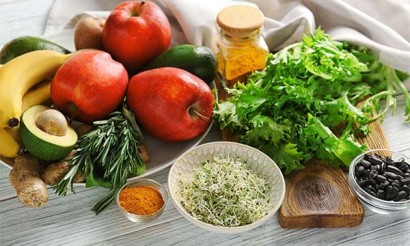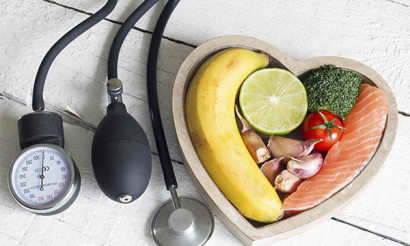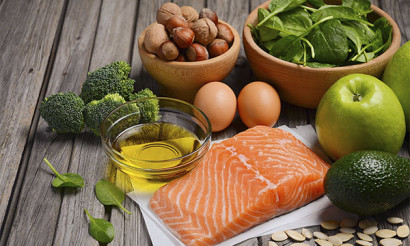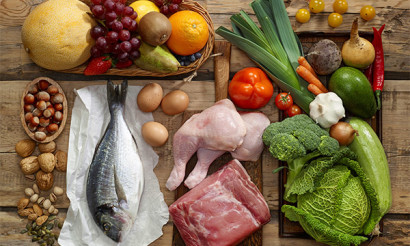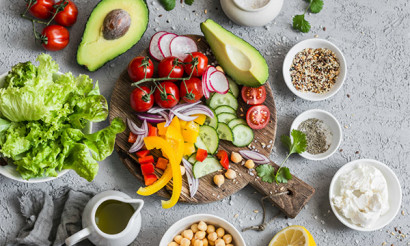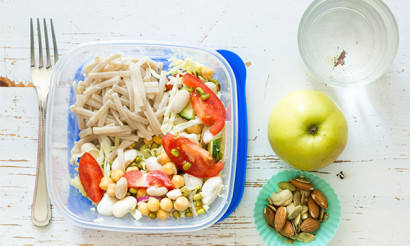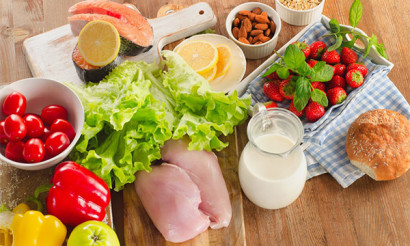Nutrition and diet for diabetes: what you can and can not eat?
Diabetes mellitus in the last decade has become a pandemic. The number of cases increases exponentially every year. Millions of people around the world suffer from this endocrine disorder. And the disease affects not only adults, but even very young children.
- What is diabetes mellitus
- Types
- Causes of diabetes
- Symptoms of the disease
- The dangers of diabetes
- Basic rules of nutrition for diabetes
- What is a bread unit
- The importance of self-monitoring
- Diabetes nutrition: a list of allowed foods
- What not to eat with diabetes
- What you can and can't drink with diabetes
- Substitutes for Diabetics
- Diabetes diet menu
- Table №9
- Diet for the 1st type
- Diet for the 2nd type
- Menu for gestational diabetes
- Consequences of not following the diet
- Recipes for Diabetes Mellitus
- Pizza Like in Italy
- Tomato Soup with Pumpkin
- Cottage cheese dessert with berries
Currently, the WHO carries out a lot of activities aimed at the prevention of this insidious pathology. According to leading experts in the field of endocrinology, the most effective measure to curb the progression of the disease is a well-balanced individual program of dietary nutrition. Everyone with diabetes, regardless of their type, can have the right diet to stabilize their health. But to achieve a positive result, it is necessary to have an idea of what role diet plays in the life of a diabetic.

Let's focus on the causes and provoking factors of diabetes, the rules of forming a diet for patients with different types of the disease. We will also give some recipes for tasty and nutritious dishes that will decorate the strict menu of such patients.
What is diabetes mellitus
This is a complex disease associated with insufficient synthesis of the hormone insulin. This function is performed by the pancreas. As a consequence of this endocrine disorder, the blood glucose content increases, which, in turn, leads to the disruption of all metabolic processes. Diabetes mellitus never develops from nothing. It is triggered by different causes, one of which is an improper diet or an unbalanced diet.
According to the latest WHO data, the main cause of diabetes today is obesity. Therefore, all persons who are prone to obesity are at risk. This point should always be taken into account. It is also very important to recognize the disease at the earliest stages of its development. There is a whole group of signs that should not be overlooked. The condition of pre-diabetes is indicated by:
- increased thirst;
- a constant dryness in the mouth;
- increased appetite;
- frequent urination.
This condition can last for several years, because diabetes in most cases is not prone to rapid progression. But there are malignant forms of the disease, when there is a rapid deterioration of a person's condition.
Types
According to the International Classification of Diseases (ICD), the latest version of diabetes mellitus is divided into two main types: insulin-dependent (type 1) and insulin-independent (type 2).
Let's look at the features of each type of diabetes:
- Type 1 diabetes. This form of endocrine pathology most often affects children and young people under 30 years of lean build. The pancreas is practically unable to produce insulin or produces it in amounts which cannot handle even minimal amounts of glucose. The result of this disorder is an increase in blood glucose levels, very quickly sugar appears in the urine. To stabilize the condition of such patients, they are administered insulin. For each patient, the doctor determines the individual dose of the drug. For this reason, this form of the disease is called insulin-dependent. Out of the total number of clinical cases, type 1 diabetes is registered in 10-15% of all patients. It is the most severe form of the disease, because patients have to take insulin injections for the rest of their lives.
- Type 2 diabetes is the most common form of the disease. It mainly affects women after the age of 50 who have weight problems. Therefore, quite often this form is called "elderly diabetes". Although the body produces insulin in sufficient quantity, tissues lose sensitivity to it. Because the cells don't get enough glucose, i.e. they are deficient, patients are constantly experiencing a strong sense of hunger. Trying to drown it out, they pile on the food rich in carbohydrates, which only worsens the situation. Over time, obesity develops. Interestingly, the second type of diabetes in 90% of cases is inherited. Also accompany its appearance of hormonal disorders, overeating and sedentary lifestyle. This type of disease is well corrected through a balanced diet.
- Gestational diabetes. This form of diabetes occurs only in pregnant women. Hormonal changes in the body of expectant mothers lead to a blockage of insulin production, which affects blood sugar levels. Usually after delivery, the woman's condition normalizes.
Classification of diabetes would be incomplete without naming the forms of the disease. According to the degree of severity, diabetes is divided into the following types:
- First degree. This is the most favorable for the patient variant of the course of the disease. The blood glucose index is no higher than 6-7 mmol/l, there is no sugar in the urine. Hemoglobin and other parameters are normal. With this degree of diabetes, the process can be compensated.
- Second degree. It is characterized by partial compensation. Complications in the form of lesions of the eyes, skin, nervous and cardiovascular system typical for diabetes are noted. Blood glucose values are 7-10 mmol/L.
- Third degree. This is a rapid progression of the pathological process. Sugar levels vary between 13-14 mmol/liter, and protein and glucose are present in the urine. Visual acuity decreases progressively, dysfunctions of other target organs appear. Sensitivity of the lower extremities decreases.
- Fourth degree. Pathological process reaches the stage of absolute decompensation, severe complications appear. Glycemia reaches critical values: up to 25 mmol/l and higher. The patient's condition is difficult to correct, renal failure develops, non-healing ulcers appear, and gangrene on the feet is not uncommon. The fourth degree is characterized by frequent recurrences of diabetic coma.
Regardless of the type of diabetes, the main problem for the patient is that against a background of high sugar levels, tissue cells do not receive enough carbohydrates. To reduce the load on the pancreas and to reduce sugar spikes, some of the carbohydrates consumed should be removed from the diet. The emphasis should be placed on slow carbohydrates, rather than fast ones, which give a feeling of satiety. Since fatty foods stimulate the secretion of GI enzymes, it is necessary to completely eliminate them from the diet.
Causes of diabetes
Diabetes mellitus is considered the most common problem of our time. And the pathology is rapidly increasing its zone of influence. Especially often the inhabitants of developed countries suffer from endocrine disorder. This trend is explained by the influence of environmental factors. But the main provocateur is obesity.

At the heart of the development of different types of diabetes are fundamentally different causes. In patients with the first type, when viral infections or during autoimmune reactions, there is a breakdown of beta cells responsible for the synthesis of insulin. As a result, a deficiency occurs, which threatens with tragic consequences. The second type of diabetes allows the patient to hope for a more favorable prognosis. Among the main provoking factors contributing to the development of DM are:
- Overeating. Much depends on a person's eating behavior. If he has an increased appetite, which requires a large amount of caloric food to satisfy, then there is a high probability of obesity. It should not be forgotten that obesity is the main cause of diabetes. Scientists have proven that if you are 50% overweight, you have a 60% incidence of the disease.
- Autoimmune pathologies. Thyroiditis, lupus, hepatitis, glomerulonephritis are very often complicated by diabetes.
- Genetics. Diabetes mellitus is much more often transmitted from parents to children. And the risk remains throughout life.
- Viral infections. The most dangerous are considered hepatitis, rubella, chickenpox, and mumps.
In addition to the main causes, there are associated factors:
- stress, nervous tension;
- Irregular eating habits;
- A poor or overly saturated diet;
- hypodynamia;
- Love of fatty, salty, sweet foods;
- frequent snacking;
- consumption of convenience foods;
- Poor environmental environment.
All of these causes can lead to diabetes when circumstances coincide. Therefore, it is very important to engage in prevention, and at the appearance of the first symptoms immediately consult a doctor. Particular attention should be paid to their health to people who are at risk. Those with a burden of heredity should undergo medical examinations twice a year, avoid overeating, and lead an active lifestyle.
Symptoms of the disease
Clinical manifestations in diabetes depend on three key points:
- The level of pancreatic insulin secretion.
- The duration of the course of the pathological process.
- Individual characteristics of the patient.
In the first type, all symptoms are usually pronounced, and in the insulin-independent form, at the initial stage, clinical signs are blurred, but over time the disease progresses. But both forms are characterized by common symptoms of the disease, which should serve as a serious signal. These include:
- Increased fatigue;
- drowsiness;
- persistent weakness;
- Rapid urination;
- persistent thirst;
- dry mouth;
- slow healing of wounds;
- smell of acetone from the mouth;
- skin irritation;
- frequent infections;
- itching of the skin and genital area;
- tachycardia;
- frequent breathing;
- Rapid weight loss (in type 1 diabetes);
- visual impairment.
If one or more of the signs in this list periodically bother a person, it is necessary to immediately go to a medical facility to have a sugar test. The combination of the classic signs of diabetes - frequent urination and thirst that cannot be quenched even by drinking large quantities of fluid - should be especially alarming. These two symptoms are related to each other, because the impressive amounts of fluid drunk increase the load on the kidneys. Sugar is excreted along with the fluid. The cyclical recurrence of these symptoms leads to dehydration of the body, forcing the person to drink water without end.
Important: The first warning sign should be hypertension (high blood pressure) combined with excess body weight. In medicine, this duo of signs is called metabolic syndrome.
The dangers of diabetes mellitus
Diabetes mellitus, even with a favorable course, does not pass without a trace on a person's overall health. The endocrine system regulates all vital processes in the body, and diabetes is one of the most common disorders. All complications of diabetes are divided into two groups: early and late.
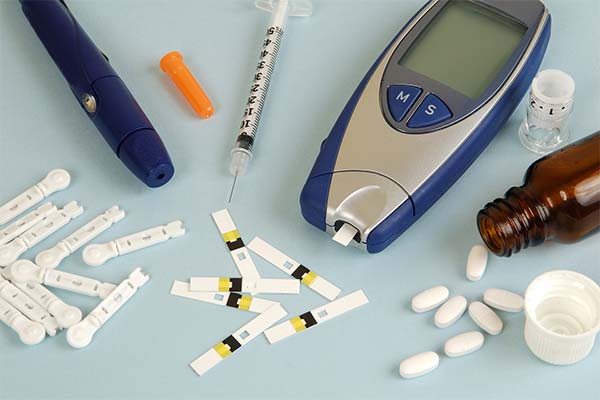
Early complications develop within a few days and sometimes hours. But after the acute symptoms have subsided, they go away. Such conditions include:
- Diabetic ketoacidosis. An extremely severe condition in which ketone bodies, products of intermediate fat metabolism, accumulate in the blood.
- Hypoglycemic coma. This is a critical condition when glucose levels drop sharply. Hypocomia happens because of an overdose of insulin or other sugar-lowering drugs. This condition often develops with the use of hard alcohol.
- Hypersmolar coma. Occurs mostly in elderly patients. The critical condition is associated with dehydration.
- Lactocidotic coma. Develops in diabetics over 50 years of age due to excessive levels of lactic acid in blood. Usually this complication occurs against a background of cardiac or renal insufficiency, hypoxia, but can be a consequence of lactic acid accumulation in the tissues.
Late complications develop over several months or progress over years. In the list of distant consequences of diabetes mellitus:
- Diabetic retinopathy. This retinal lesion, characteristic of DM, is especially common in patients with type 1. Point hemorrhages in the sclera, the formation of false vessels over time lead to retinal detachment and complete loss of vision.
- Angiopathy. This medical term refers to a vascular permeability disorder. If the disease progresses, it leads to thrombosis and early atherosclerosis. DM affects mostly small peripheral vessels.
- Polyneuropathy. Against the background of progressive diabetes, it most often affects the lower extremities first.
- Nephropathy. One of the most frequent complications of diabetes. The disease is accompanied at first by a small amount of protein in the urine, followed by proteinuria. As a result, renal failure develops.
- Arthropathy. Develops due to a decrease in the volume of synovial fluid. Deprived of "lubrication" joints begin to produce a crunch, and their mobility is limited.
- Ophthalmopathy. This is also a complication of the visual organ is very common in diabetics. In addition to retinopathy, such patients early develop cataracts (clouding of the lens).
- Encephalopathy. Against the background of severe diabetes, it manifests itself in the form of changes in the psyche and emotional mood.
- Diabetic foot. This is a form of remote consequences of the disease, when the feet are affected by non-healing deep ulcers. The process affects bone tissues and joints, leaving extensive foci of necrosis. Therefore, the most radical method of treatment - amputation of the foot - is used to prevent its spreading.
- Intensive weight loss. Basically, such an unfavorable scenario is followed by insulin-dependent diabetes. And in other cases, the dynamics of this process is so intense that within a few months the patient loses up to 20-30% of the original body weight. And all this happens against a background of abundant diet. As the process progresses, it ends in extreme exhaustion of the body.
As we can see, all the consequences of diabetes pose a threat not only to health, but also to life expectancy of such patients in general. The saddest thing is that with severe diabetes, such complications appear in a very short time. Therefore, you should never ignore the first "bells" that the body gives out. After all, it is better to be checked once more than to suffer the rest of your life from a serious illness.
Basic rules of nutrition for diabetes
A dietary allowance for diabetes mellitus - this is the basic foundation of the component therapy. Along with the use of insulin or medications that lower sugar levels, a properly formed diet provides partial compensation for impaired carbohydrate metabolism. It is worth noting that with the second type of disease it is possible to restore normal metabolism only through a balanced diet. Especially good results are achieved in the early stages of the disease. And with type I diabetes, diet is a vital standard. Any deviation can cause catastrophic consequences and even end in death.
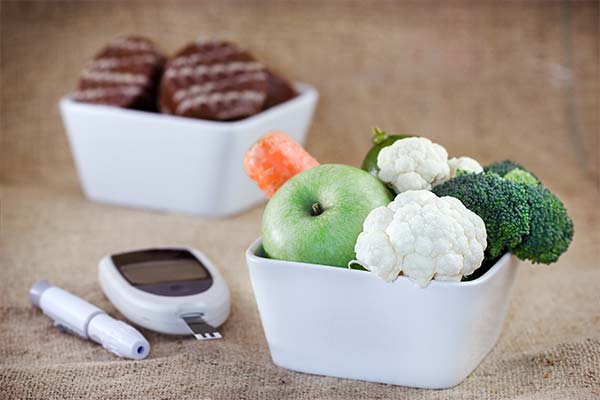
Rules for the construction of the diet of diabetic patients:
- The diet must be balanced in fats, carbohydrates and proteins. Caloric content is also always taken into account.
- Easily digestible carbohydrates are completely excluded from the diet. The only exceptions are hypoglycemia cases.
- Constant control of body weight is one of the prerequisites. It is especially important to monitor weight in patients with type 2 diabetes.
- For a successful nutrition program, it is necessary to keep a diary, where you note the daily menu and the number of bread units. How to calculate this figure, we will tell a little later.
By the way, keeping a diary helps to identify episodes of hypo or hyperglycemia, which will help to adjust the adequate doses of insulin or sugar-lowering drugs.
What is a bread unit
Basically, this is the main indicator in diet therapy for diabetes of any type. This parameter is, in fact, a conventional measure that is comparable with 10-12 g of carbohydrates or 20-25 g of bread. You can easily calculate this figure with the help of a special table, which gives bread units for different products. There are different intake rates for each patient, but on average the total number of bread units per day should not exceed 18-25 units. Of course, much depends on the weight of the person and the degree of physical exertion that he is experiencing.
Dietitians recommend not more than 7 bread units at one meal. And it is desirable that this norm is traced in all daily meals.
It is worth noting that, thanks to the wide awareness of the population, modern diabetics (if I may say so) are well aware of the importance of daily counting of bread units. They handle the calculation of this indicator on their own.
Important: Alcohol can lead to distant hypoglycemia or cause a hypoglycemic coma.
The importance of self-monitoring
Continuous monitoring of glucose levels is another important aspect of all measures taken to compensate for carbohydrate metabolism. Unfortunately, the current level of medical technology does not yet allow us to simulate the secretory activity of the RV. In addition, glucose levels during the day are not stable, because they change under the influence of stress, physical exertion, and general state of health.
Since there is no possibility to keep diabetics permanently in the hospital, they have to monitor their glucose levels on their own. To date, there are two effective methods of monitoring:
- Special test strips, which can be purchased in the pharmacy. This method gives a rough estimate of the glycemic level.
- Glucometer. This device does not require special skills, but allows you to get an accurate measurement result. Portable glucose meters today are actively purchased by people with diabetes. The test procedure is simple: just one drop of blood should be placed on a disposable plate, and in a minute the device will give the test result. Although there are errors in this type of glycemic measurement as well, the difference in this situation will not be more than 1-2 units.
Despite the fact that a certain diet is recommended for patients with any type of diabetes, there are some differences in the diet of such patients.
type 1
For this category of patients, a proper diet is considered a necessary background for adequate insulin therapy. If one does not adhere to the basic principles of diet, all efforts aimed at stabilizing sugar levels will be wasted. As a result of such neglect - the development of complications of the vascular system, vision and other organs. Patients with type I diabetes need a low-calorie diet (up to 30 kcal per 1 kg of weight) and strict compliance with the schedule of meals. When drawing up the diet, priority must be given to the balance of calories and fat.
type 2
As we have already noted, with type 2 diabetes, especially in the early stages, you can do without medication therapy. First, the patient is prescribed a diet, which will help to remove extra pounds. The daily caloric content of the diet should be no more than 1800 kcal. Such a diet will help to reduce weight weekly by about 400 grams. If the patient has obesity, then the number of calories is reduced to 15-17 units per 1 kg of weight. With positive dynamics, such a diet will be enough for both weight correction and stabilization of blood glucose levels.
Regardless of the form of diabetes, the food of such patients should contain vitamins and mineral supplements. Therefore, it is sometimes useful to use for this purpose beer yeast, decoction of rosehip, dietary supplements.
Note: The type of diabetes is determined only by an endocrinologist. He also deals with the choice of dietary options.
Diabetes nutrition: a list of allowed foods
The main question on the minds of all diabetic patients concerns the choice of a food basket. After all, each ingredient must be evaluated according to different indicators, but the main one is the ability to raise sugar levels. In addition to a competent choice of basic foods, you need to pay attention to the mode of eating, portion size and a number of other very important points. Therefore, before listing the allowed and prohibited foods to eat, let us dwell on the basic principles of nutrition for diabetics.
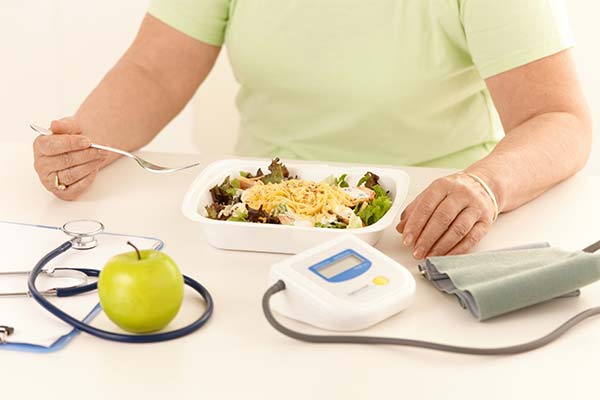
Key principles:
- A sick person's meals should be fractional - up to 5-6 times.
- The portion size should be reasonable. Too small portions will only increase hunger.
- The daily amount of calories is best divided equally at each meal.
- The caloric content of the daily diet should be commensurate with the energy expenditures.
- Most foods high in polysaccharides (of plant origin) should be eaten in the first half of the day.
- The patient should try to eat around the same hours. Under no circumstances should skips be allowed in the schedule. Strict adherence to the diet will avoid hypoglycemia.
- Weight control is another prerequisite for all diabetics, regardless of the type of disease.
- In spite of restrictions, the diet must be complete. Elevated sugar levels should not be seen as a reason to give up carbohydrates completely. Simply, when drawing up a daily menu, you should give preference to plant foods, especially greens and buckwheat. If it is difficult to do without sweets, sugar can be replaced by natural sweeteners from the approved list. Do not forget that carbohydrates are the main source of energy.
- For those with type 2 diabetes, it will be helpful to switch to dietary foods that are made from amaranth flour. They help to overcome cravings for overeating and are great for a hearty snack. At the same time, such products do not contribute to an increase in glucose levels.
- It is also important to choose the right proportions of fat in the diet. To exclude them completely would be a fatal mistake, because they are necessary for the body. Fatty foods should account for about a third, and preference should be given to vegetable oils: linseed, olive and amaranth oils.
- Fiber is necessary for a complete diet. Dietary fiber doesn't increase sugar concentration, but it can help with digestion and replenish the energy reserves.
These are the basic principles of a dietary program for people with diabetes. Now let's look at the list of foods allowed for consumption.
What must be included in the diet:
- Bread. It is better to buy special bread for diabetics or black bread. The daily rate - 200 grams.
- Vegetables, fresh herbs. Potatoes, carrots, beets are allowed up to 200 g, but no more. Cabbage, cucumbers, radishes, zucchini and tomatoes are allowed to eat in unlimited quantities. It is also useful for diabetics to eat fresh greens daily in any form of preparation. The exception is spicy crops.
- Cereals and pasta. It is allowed to consume 2 times a week, as well as dishes made of beans. But in this case, you will have to reduce other carbohydrates.
- Eggs. They can be eaten (up to 2 pieces) in any form.
- Sour fruits and berries. Must be present in the menu every day. Norm - up to 300 grams.
- Milk and dairy products (with the permission of the doctor). Included in the diet in pure form or as part of other dishes. Portion of sour milk and kefir - up to 2 cups. Especially worth the load on the cottage cheese. Allowed portion per day - up to 200 g. You can add cottage cheese to porridges or make puddings, cheesecakes, casseroles.
- Bran. They are very useful for diabetics. They have a lot of fiber, which is good for digestion and normalization of liver function.
- Meat products. Cook everyday dishes should be made only of dietary types of meat: veal, rabbit, chicken. It is better to boil or cook food on steam.
- Soups. It is allowed to cook on a weak meat or vegetable broth.
- Fish and seafood (especially seaweed is good for diabetes). Must be present in the weekly menu 1-2 times.
All products for dietary nutrition for diabetics should have a glycemic index below 50. This will prevent the development of hyperglycemia, but at the same time they do not allow the sugar level to fall to a critical level. Garlic, avocados, asparagus, hazelnuts and artichokes are particularly useful in this regard.
Useful tip: As for your favorite sweets, you have to find a replacement for them. For example, instead of ice cream, you can have a small portion of frozen bananas whipped with a mixer. The result is a wonderful dessert. A piece of dark chocolate instead of candy can also afford once a week.
What you can't eat with diabetes
Now it's the turn of the "black" food list. The following foods are strictly prohibited:

- All sweet delicacies: honey, candy, jam, jams.
- Confectionery: cakes and pastries from puff pastry, rolls from white refined flour.
- White bread.
- Pickles and marinades of vegetable products.
- Spices and store-bought condiments, including sauces and mayonnaises.
- Sweet fruits and berries, including dried fruits.
- Semi-finished and canned foods.
- Whole milk and condensed milk.
- Prepackaged snacks.
- Lard and fatty meats.
- Smoked meats.
- Fatty fish.
- Soups with fatty meat broth.
- Margarines and spreads.
- Chips and other fast foods.
Also on the banned list are certain types of cereal products and starch. All the foods on the "black" list will have to be abandoned for the rest of your life. But even with such a limited choice you can make a varied menu. Replacing fast carbohydrates with slow ones will help maintain health and provide the body with the necessary resource of energy.
What you can and can't drink with diabetes
Unfortunately, even dietary guides pay much less attention to beverages than to the food set. But diabetes is a disease in which any little thing you miss can deal a crushing blow to your health. Given the fact that most diabetics suffer from a constant sense of thirst, we decided to pay attention to beverages, too.
First, let's list the drinks that are forbidden to drink. This list should include:
- Fresh juices. It is categorically forbidden to drink packaged drinks.
- Alcohol, including wines and beers made from powdered concentrate.
- All kinds of sodas.
- Steamed milk (it has too high a GI).
- Syrups.
Alcohol: pros and cons
Separately we should talk about alcoholic beverages. There is an opinion, which is supported by some endocrinologists, that patients with diabetes can occasionally afford a good glass of wine. Of course, it is impossible to plan, like a menu, all life in advance. Indeed, sometimes it's worth relaxing. But it is necessary to remember that even good vintage wines do not carry substantial benefits, but may provoke an increased feeling of hunger. And uncontrolled consumption of food always leads to an increase in the sugar curve, which often becomes the cause of hyperglycemia.
List of useful drinks
Almost all diabetic patients are partial to drinks, because they are constantly thirsty. Water, like no other liquid, is able to quench this feeling. The daily rate of consumption should be at least 1.5 liters of pure water.
You can also drink without fear:
- Mineral medicinal water. It contains trace elements and salts.
- Chicory. Nutritionists strongly recommend that all diabetics prepare drinks from it.
- Teas. Especially useful for health are green varieties, as they have a powerful antioxidant activity. Black tea can also be drunk, but it is better to dilute it with milk to reduce the effects of caffeine.
- Herbal infusions and decoctions. They can be drunk instead of tea or water.
- Coffee. It is allowed to include in your daily menu one small cup of tonic drink made from ground whole grains. If diabetes is accompanied by hypertension, it is better to refuse coffee drink.
- Kisses. They stimulate intestinal motility. But potato or corn starch has a high GI. In order not to deny yourself the pleasure, you can prepare kissel on oat flour, replacing sugar with any sweetener.
- Milk has a positive effect on liver and gastrointestinal functions. Diabetic patients should always drink up to two glasses of chilled milk per day. Steamed milk is forbidden.
- Cocoa and milk. This drink, loved by everyone, will benefit a sick person if it is prepared from quality powder with no more than 15% fat content. Two cups of freshly brewed cocoa with milk can be drunk daily. You can add ½ tsp. cinnamon to improve the taste and flavor of the drink.
- Fermented milk drinks: ryazhenka and kefir. They, too, can be included in the daily menu.
- Tomato and pumpkin juice. Bring vitamin variety to the diet.
Useful tip: even with such a rather limited choice, applying imagination, you can get interesting options for drinks. For example, make green tea with ice or add currants to kefir.
Sweeteners for diabetics
As sweeteners, dietitians recommend the use of sugar substitutes for diabetics. They come in two varieties: natural and synthetic.

A brief overview of natural sweeteners:
- Fructose. At its core, the product contains extracts from berries, vegetables and fruits, as well as honey. Fructose should not be used by people with weight problems. Although it is twice as sweet as regular sugar, it has a fairly high caloric value - about 4 kcal/g, and the GI is 20.
- Sorbitol. This is a six-atom alcohol, which has the form of a crystalline powder with a sweetish taste. This is the second most popular natural sugar substitute. It does not taste as sweet as the original product, but its caloric value is 2.6 kcal/g. In large quantities sorbitol should not be consumed, as it can lead to complications: diabetic retinopathy, flatulence and other intestinal disorders.
- Stevia. This sugar substitute is obtained from the seed of the plant of the same name. This is a safe and very healthy product for diabetics. In moderate quantities it can be consumed in any type of disease. The GI of stevia is close to zero. But abuse of this sweetener can lead to a sharp decrease in BP. Side effects in the form of allergic reactions are possible.
- Xylitol. This is another product that is a derivative of sugar alcohol. It is obtained from agricultural plant waste products. In terms of sweetness, xylitol is closer to sucrose, but has no biological value. In addition, the product worsens the condition of tooth enamel and has a laxative effect.
- Taumatin. Banned for sale in the CIS countries, but in Israel and Japan is actively used as a sugar substitute of protein nature.
Synthetic sweeteners
Artificial sweeteners are obtained by chemical synthesis. They are available in the form of tablets. The advantage of such drugs is that they are quickly eliminated from the body and do not affect the glucose level. You can buy synthetic sugar substitutes in the pharmacy or specialized departments of stores. Among the most popular products from this line are:
- Aspartame. A noisy drug, around which the controversy does not cease. It is actively used in the food industry, where it is labeled E-951. The low caloric value combined with a zero glycemic index is a definite plus. But the disadvantages are much greater, as many side effects have been identified with frequent use. This sweetener is contraindicated in children and pregnant women, prohibited in neurological disorders and depression.
- Cyclamate (E952). This is a very sweet substitute. It does not lose its qualities when exposed to high temperatures, so it is allowed to be added directly to hot dishes.
- Saccharin (E954). This is the very first artificial sugar substitute. But it is not recommended to use it in large quantities, as scientists have proven that it can provoke the development of malignant tumors.
- Sucrasite. It consists of soda, fumaric acid and saccharin. The product has its own disadvantages, since saccharin is present in the composition.
- Neotame. It is a relatively new product, which is thousands of times sweeter than the usual sugar. Neotame is obtained from aspartame, but it is resistant to temperature. Today it is neotame that is considered to be the safest synthetic sugar substitute.
- Sucralose. Another representative of the new generation of substitutes. The product is obtained from sugar using a special technology. It is a very sweet and safe analogue.
It should be remembered that even a safe sugar substitute when abused can show its negative qualities. Therefore, such supplements need to be strictly dosed.
Diet menu for diabetes mellitus
Knowing the basic principles of nutrition in diabetes, the sick person can independently draw up a weekly menu, if necessary, making adjustments to it. A clear guide for productive work in this direction will be a list of allowed products. On the forbidden culinary delights, too, can not be forgotten. Initially, it is worth asking for help from specialists who will explain how to calculate the bread units and caloric content of the daily menu. In therapeutic dietetics, the main dietary program for diabetics is Table No. 9.
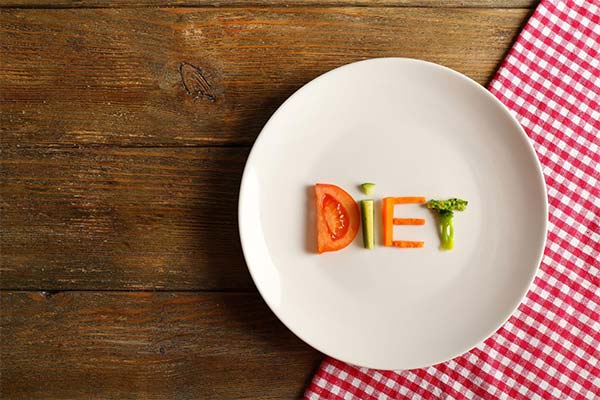
Table No. 9
This version of the diet is designed for people with diabetes, taking into account all the restrictions, as well as the need for the body to regularly receive micronutrients and vitamins.
The main principles of table No. 9:
- The daily food schedule includes two breakfasts, lunch, afternoon snack and dinner.
- Try to eat at equal intervals.
- It is better to boil or steam food. But you can also stew or bake it in the oven, but without the crust.
- The food should be served warm.
A sample menu for the week
Monday:
- First breakfast: crumbled buckwheat porridge with milk, tea, sandwich with butter.
- Second breakfast: orange.
- Lunch: Vegetarian cabbage soup, fish cutlets with mashed potatoes, compote.
- Afternoon snack: kefir (1% fat).
- Dinner: nonfat cottage cheese pudding.
Tuesday:
- First breakfast: pureed liquid oatmeal on water with milk, a small piece of cheese, tea.
- Second breakfast: Apple.
- Lunch: soup with weak chicken broth, boiled beef with pumpkin puree, compote.
- Afternoon snack: rosehip brew.
- Dinner: stewed cabbage, boiled egg.
Wednesday:
- First breakfast: steamed protein omelet, green tea.
- Second breakfast: Kefir.
- Lunch: buckwheat soup with a piece of chicken breast, boiled fish with vegetables.
- Afternoon snack: vegetable salad (carrot, apple, cabbage).
- Dinner: cottage cheese with berries, tea.
Thursday:
- First breakfast: boiled rice porridge, cocoa.
- Second breakfast: fruit smoothie made from berries and apples.
- Lunch: borscht in weak broth, a piece of boiled turkey, vegetable salad.
- Afternoon snack: yogurt.
- Dinner: stewed carrots, hake.
Friday:
- First breakfast: cheesecakes with sour cream, tea.
- Second breakfast: apple and carrot juice.
- Lunch: vegetable soup with peas, steamed chicken cutlet with noodles, rosehip broth.
- Afternoon snack: plain yogurt.
- Dinner: steamed omelet.
Saturday:
- First breakfast: buckwheat with apples, herbal tea, cheese plate.
- Second breakfast: decoction of rose hips and cherries.
- Lunch: Beetroot soup with sour cream, beef stew with vegetables, compote.
- Afternoon snack: baked apple.
- Dinner: soft-boiled egg, salad with vegetables and onions, dressed with olive oil.
Sunday:
- First breakfast: liquid oatmeal with milk, chicory drink.
- Second breakfast: Fresh berries or kefir.
- Lunch: Millet vegetable soup, fish stewed in tomato sauce and carrots, potatoes.
- Afternoon snack: apple juice.
- Dinner: vegetable casserole (zucchini cauliflower).
Addendum: Endocrinologists believe that Diet #9 is an ideal example of proper nutrition for diabetic patients. Each meal is balanced in terms of the content of the BFA. Therefore, this dietary scheme should become the standard for such patients.
Diet for type 1
To form a proper nutrition program, it is better to use the help of professionals. Over time, the patient will be able to do this on his or her own. In the meantime, here are two examples of therapeutic diets for the day.
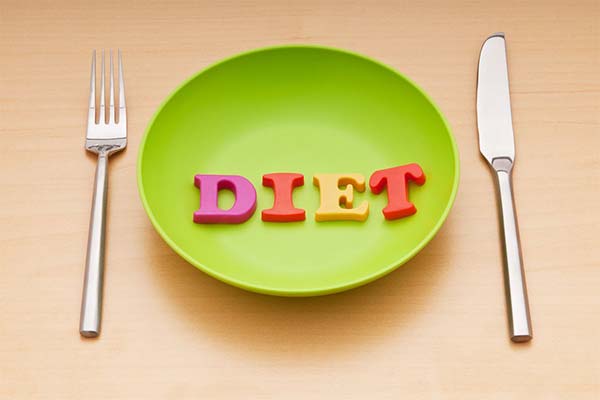
The first option:
- Breakfast: boiled pearl barley, tea, hard cheese.
- Lunch: fruit mousse.
- Lunch: borscht without roasting, boiled chicken, stewed cabbage.
- Dinner: vegetable salad and a piece of boiled beef.
- Evening snack: three cheese cakes.
The second variant:
- Breakfast: steamed protein omelet, piece of steamed veal, weak coffee.
- Lunch: grapefruit, kefir.
- Lunch: pumpkin soup, steamed fish cutlet, vegetables.
- Dinner: souffle cottage cheese, rosehip broth.
- Evening snack: yogurt.
Diet for the 2nd type
Only at first glance it may seem that dietary compliance with diabetes is a difficult task associated with deprivation. Of course, there are restrictions and quite serious, but with a competent alternation of dishes and daily menus, the sick person can eat tasty and useful. In this respect, patients with type 2 diabetes are in a better position.
Example menu #1:
- Breakfast 1: cottage cheese, carrot and apple salad, bran bread, green tea.
- The second breakfast: apple, mineral water.
- Lunch: vegetable soup with soy, beef goulash, zucchini caviar, tea.
- Afternoon snack: fruit salad and yogurt.
- Dinner: steamed fish schnitzel, stewed cabbage, rosehip decoction.
- For the night: kefir.
Example of menu № 2:
- Breakfast 1: oatmeal with milk, egg, coffee.
- Second breakfast: homemade yogurt with fresh berries.
- Lunch: soup with vegetables, steamed chicken, vegetable salad, compote.
- Afternoon snack: cottage cheese and tea.
- Dinner: fish (hake) baked in sour cream, stewed cabbage with tomatoes and carrots, cocoa.
- For the night: kefir or a baked apple.
The norm of bread for each meal - 50 grams.
Important! A person suffering from type 2 diabetes should not experience hunger. You should always remember about it. If in between there is a desire for a snack, you are allowed to drink tea or compote.
Menu for gestational diabetes
This type of disease is considered temporary, because after the birth of the baby, the activity of the endocrine system returns to normal. Such a condition develops mainly in those women who have risks in any hereditary line. Most often, the pathology occurs in the second or early third trimester. To normalize the condition of the future mommy, it is also necessary to focus on useful products, the list of which is given above.
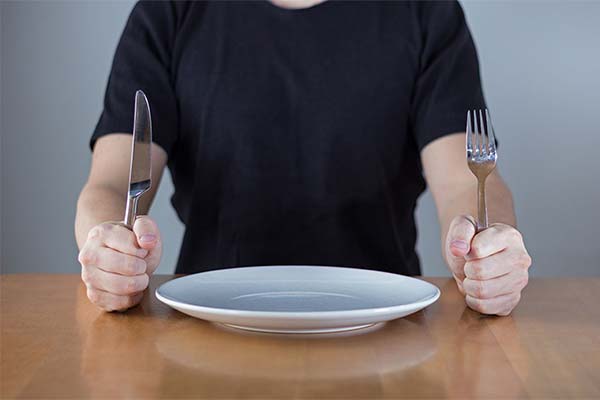
A sample menu for one day will look like this:
- Breakfast: boiled chicken fillet, salad, cocoa.
- Lunch: cheese cakes with sour cream (low fat), apple.
- Lunch: soup with beef meatballs, fish baked with stewed vegetables, compote.
- Afternoon snack: yogurt, berries.
- Dinner: boiled beef and asparagus.
- Before going to bed: kefir.
Important: The woman should be under the supervision of a doctor. Sugar levels should also be monitored on an ongoing basis.
Consequences of not following the diet
Therapeutic diets for diabetes allow the patient to lead a full life and work. A properly made diet and compliance with the meal schedule will maintain normal glucose levels. In addition, a special diet for patients with type 2 diabetes will be an effective way to lose weight. Already after the first month of such a diet, you can record a loss of several kilograms. Do not be upset about the fact that diet number 9 will have to stick to for the rest of your life. This diet program is well-balanced and has a variety of dishes.
Patients with diabetes need to remember that the consequences of not following the diet can be catastrophic. Acute and long-term complications of diabetes have a devastating effect on internal organs. Thus, the most common consequence of eating disorders - a hyperglycemic coma - in most cases develops due to a sharp increase in glucose levels. Sometimes the values exceed the threshold of 50 mmol/l. It is very difficult, and sometimes impossible, to bring a person out of a critical state. But even if it is possible to stabilize the condition, glucose "intoxication" does not go away for the patient. Frequent recurrence of episodes leads to the following complications:
- brain tissue damage;
- irreversible visual impairment up to blindness;
- renal failure;
- atherosclerosis;
- vascular complications;
- reproductive disorders in women;
- peripheral nervous system damage;
- gangrene of the lower extremities.
Hypoglycemia is no less dangerous than high sugars. Therefore, it is in the patient's own interest to keep regular control of daily glucose levels.
Recipes for meals with diabetes mellitus
Strict restrictions do not preclude the possibility of satiating your everyday menu with delicious dishes. You can add a little creativity to the recipes below to get a nice, interesting dish.
Pizza like in Italy
A somewhat unexpected suggestion for the diet of patients with diabetes. The recipe is simple, the set of products is standard, and cooking this masterpiece is easy and pleasant. It is necessary to take three varieties of flour with minimal GI: chickpea, rye and buckwheat in the ratio: 1:3:1.

How to prepare:
- First prepare the dough: to do this, add ½ tsp of dry yeast, a pinch of salt and water to the flour mixture.
- To make the dough airy, determine it for a couple of hours in a dish greased with oil, cover it.
- When the volume increases, a little knead the mass.
- Roll out small tortillas with a rolling pin.
- Fill with stuffing.
- Bake products at 220 ° C for 5-7 minutes.
Note: You can use finely chopped boiled chicken breast, cheese, tomatoes, eggs, vegetables, and other ingredients from the allowed list as a filling.
Tomato soup with pumpkin
This tasty, nutritious first course is also more suitable for the diet of patients with type I diabetes. The set of products:
- weak meat or vegetable broth - 0.7 l;
- pumpkin - 500 g;
- Garlic - 3 cloves;
- tomato puree - 500 gr;
- olive oil - 30 ml;
- salt, rosemary, pepper.
How to cook:
- Chop the pumpkin flesh, lightly fry in oil.
- Add the garlic and rosemary.
- Season with tomato puree, and let the mixture simmer for 5 minutes.
- Now put all the vegetables into the boiling broth and bring the soup to the boil.
Before serving, you can decorate with chopped greens.
Cottage cheese dessert with berries
Such a tasty treat will be liked by all the household. Therefore, this recipe is worth taking note. What you need for a culinary masterpiece:
- yogurt - 100 g;
- low-fat cottage cheese - 500 g;
- berries - a handful.
If desired, you can add nuts.
Process:
- To give the dessert the desired sweetness, add 2-3 tablets of substitute in the mass.
- The process of making the dessert is simple: combine all the ingredients, and then whip with a blender. The output should turn out a thick mass.
- On top of the dessert decorate with nut crumbs.
Note! From this set of products you can make a casserole or pudding. Only for this you need to add eggs to the curd mass, and then send it to bake in the oven.
Conclusion
You can pick up a lot of interesting recipes that will meet the strict rules of the dietary program for diabetes mellitus.
But the patient himself, as well as his inner circle should understand that only through the correct organization of food will be able to ensure a normal quality of life. There are no other alternatives for this category of patients. In other words, proper nutrition should become a norm of life for them.
«Important: All information on this site is provided for informational purposes only. purposes only. Consult a specialist before applying any recommendations. specialist before you use any of the recommendations. Neither the editors nor the authors shall be liable for any possible harm caused by materials."


